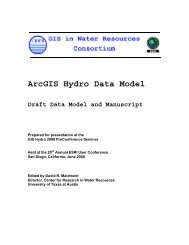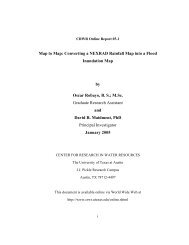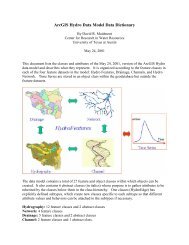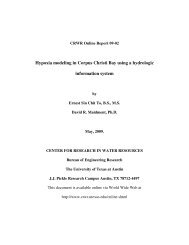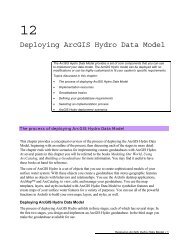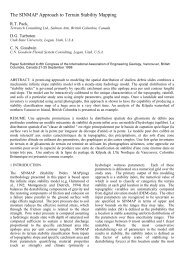View the Whole Report - Center for Research in Water Resources ...
View the Whole Report - Center for Research in Water Resources ...
View the Whole Report - Center for Research in Water Resources ...
You also want an ePaper? Increase the reach of your titles
YUMPU automatically turns print PDFs into web optimized ePapers that Google loves.
2. LITERATURE REVIEW<br />
2.1 Introduction<br />
Two strategies <strong>for</strong> m<strong>in</strong>imiz<strong>in</strong>g <strong>the</strong> impact of stormwater runoff from construction<br />
sites are erosion control and sediment control. Erosion control is a source management<br />
method and usually is accomplished with slope cover<strong>in</strong>gs. These techniques <strong>in</strong>clude<br />
temporary and permanent vegetation, plastic sheet<strong>in</strong>g, straw and wood fiber mulches,<br />
matt<strong>in</strong>g, nett<strong>in</strong>g, chemical stabilizers, or some comb<strong>in</strong>ation of <strong>the</strong> above. Sediment<br />
control may be considered as <strong>the</strong> second l<strong>in</strong>e of defense. Sedimentation ponds, post<br />
sedimentation pond devices, and silt or sediment barriers reduce sediment loads<br />
(Nawrocki and Pietrzak, 1976).<br />
Sediment barriers are devices designed to dim<strong>in</strong>ish solids load<strong>in</strong>g through short<br />
term retention and/or velocity reduction and filtration. Silt fences and rock berms are<br />
sediment barriers. Silt fences have been selected preferentially and <strong>in</strong>stalled widely<br />
because of purported advantages attributed to <strong>the</strong>se devices such as effectiveness <strong>for</strong><br />
durations greater than 6 months, stronger construction, greater pond<strong>in</strong>g depth, m<strong>in</strong>imum<br />
removal efficiencies of 75%, easy assembly, and relatively low cost (Goldman et al.,<br />
1986).<br />
2.2 Sediment Removal Mechanisms<br />
Sediment barriers capture eroded solids by sedimentation and filtration both of<br />
which contribute to <strong>the</strong> overall efficiency of a system. The most important, cost effective,<br />
and widespread treatment of suspended solids <strong>in</strong> water is by sedimentation. Gravity<br />
separation of solids that have a specific gravity greater than water has been practiced <strong>for</strong> a<br />
long time and is well understood. Stokes’ law, which is applied to calculate <strong>the</strong> settl<strong>in</strong>g<br />
velocity of solid particles, is based upon <strong>the</strong> premises of lam<strong>in</strong>ar flow, no particle<br />
<strong>in</strong>teraction, and spherical particles. This relationship is valid <strong>for</strong> estimat<strong>in</strong>g <strong>the</strong><br />
approximate settl<strong>in</strong>g velocities and provides <strong>in</strong>sight <strong>in</strong>to factors affect<strong>in</strong>g <strong>the</strong><br />
sedimentation of smaller particles, such as silts and clays (Kouwen, 1990).<br />
5




